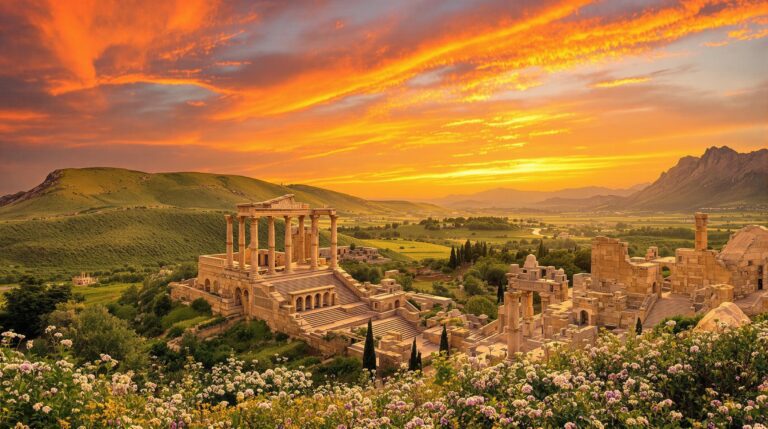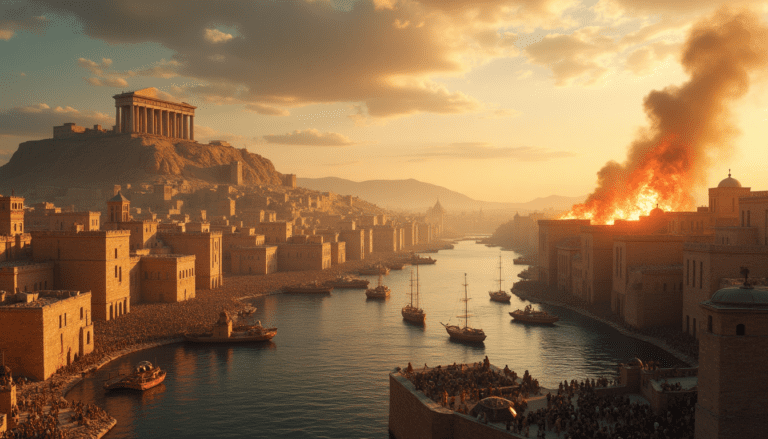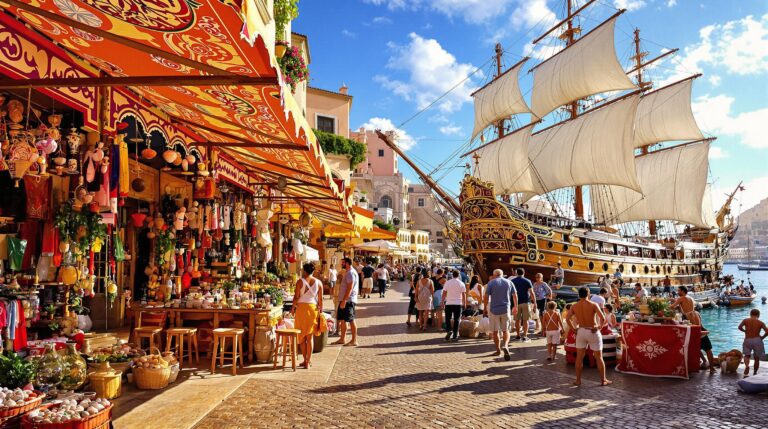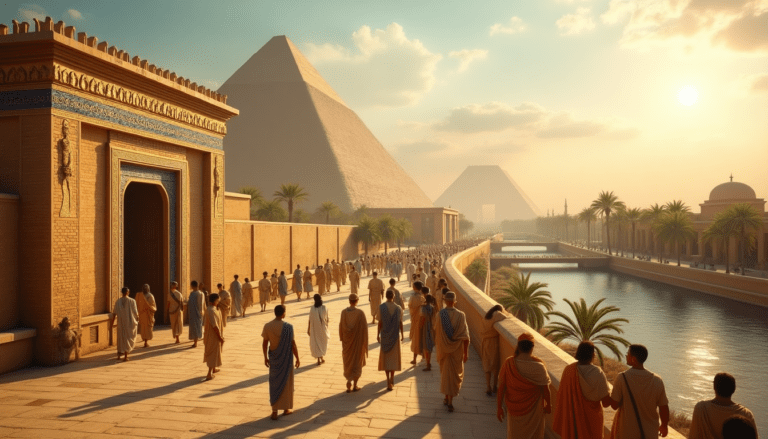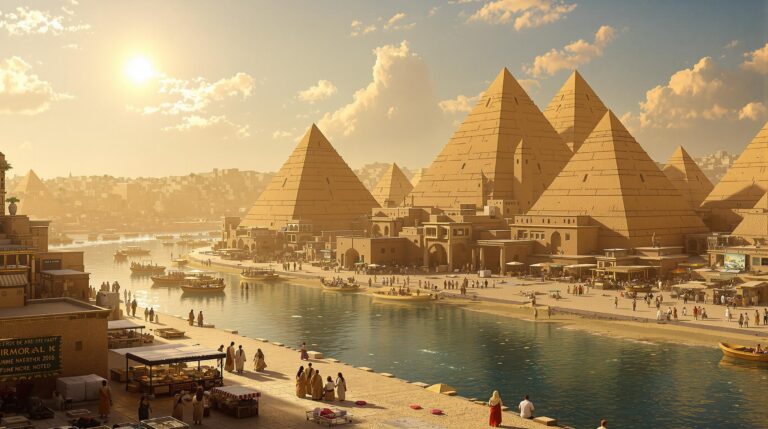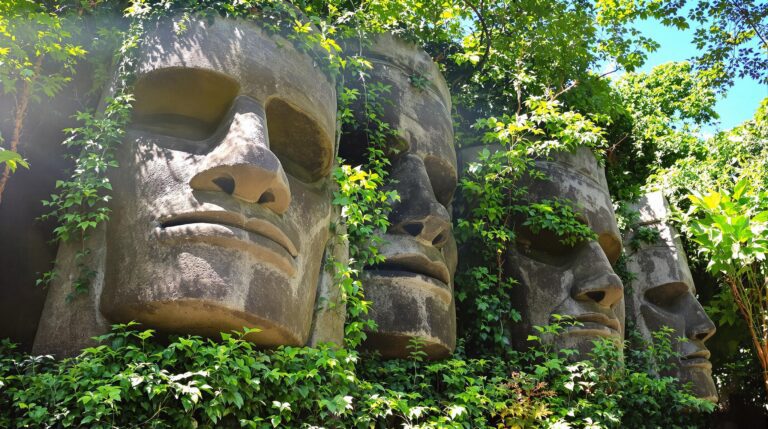Mycenaean Civilization: Heroes and Legends

The Mycenaean civilization, with its vibrant mosaic of heroes and legends, serves as a critical lens through which to understand ancient Greek values.
Figures like Agamemnon and Achilles embody ideals of bravery and honor, but their narratives also raise questions about the nature of heroism.
How did these stories shape societal norms and influence later generations? Examining the interplay between myth and memory reveals deeper insights into the cultural fabric of the Mycenaean world.
TL;DR
Hide- Mycenaean heroes like Agamemnon and Achilles became central figures in oral traditions, shaping the values and identity of their civilization.
- Epic narratives preserved by poets such as Homer highlight the heroic ideals and societal values surrounding warfare and honor in Mycenaean culture.
- The legends of the Trojan War, including the siege of Troy, illustrate the intertwining of myth and historical events in Mycenaean history.
- Archaeological evidence at sites like Troy shows Mycenaean influence, supporting the legendary accounts of their warriors and culture.
- The decline of the Mycenaean civilization prompted a shift in storytelling, as oral traditions evolved into foundational myths for later Greek society.
Origins and Rise of the Mycenaean World
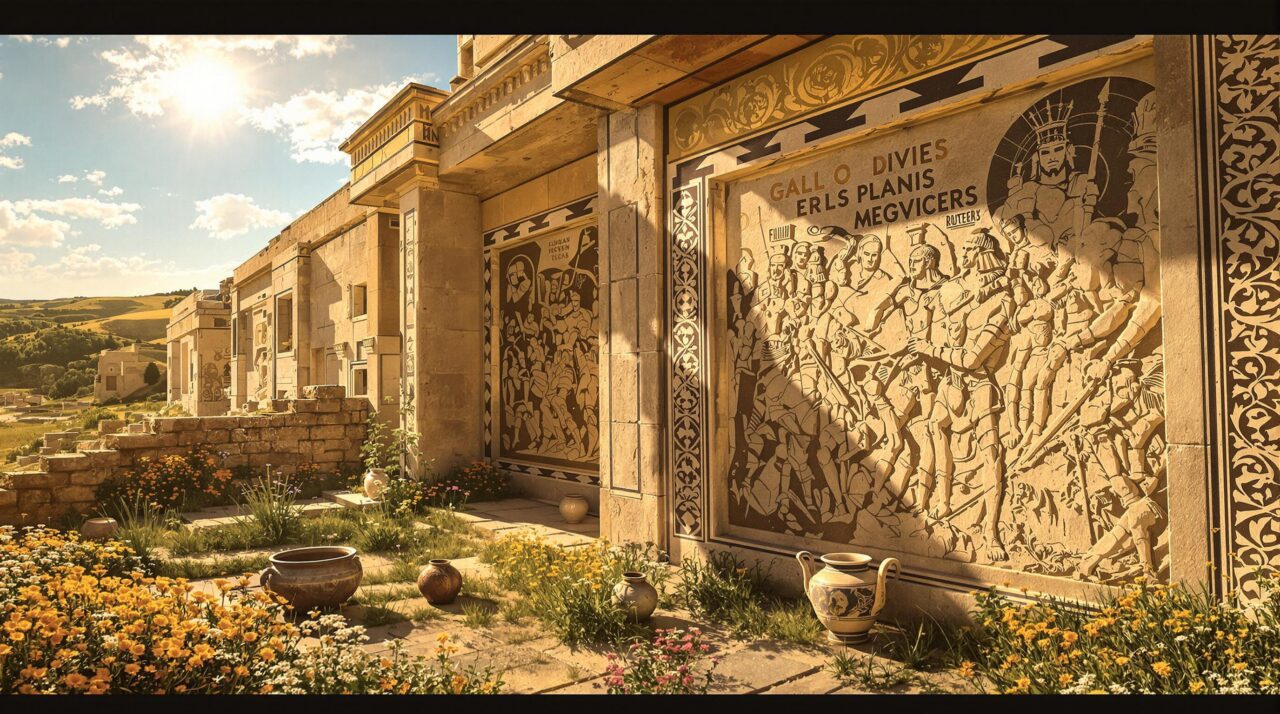
The origins of the Mycenaean civilization can be traced back to the settlements influenced by Minoan Crete, which provided critical advancements in trade, art, and architecture.
As these influences took root, a shift towards palace-centered power emerged, marking a significant transformation in social and political structures.
This evolution not only shaped the Mycenaean identity but also set the stage for their eventual dominance in the Aegean world.
Settlements and Influence from Minoan Crete
The early Mycenaean culture was greatly shaped by its trade contacts with Minoan Crete, which facilitated the exchange of goods and ideas.
This interaction led to the adoption of certain elements from the Minoan Linear A script into the Mycenaean Linear B system, marking a critical point in the evolution of their writing and administrative practices.
Such influences not only enriched Mycenaean society but also laid the groundwork for their eventual rise as a dominant civilization in the Aegean.
Early Mycenaean culture and trade contacts
Although often overshadowed by their Minoan predecessors, the early Mycenaean culture emerged as a distinctive entity characterized by significant trade contacts and cultural exchanges.
This interaction facilitated the flow of ideas, materials, and technologies, allowing the Mycenaeans to develop unique artistic styles and societal structures.
Such exchanges not only enhanced their economic prosperity but also laid the groundwork for their future prominence in the Mediterranean.
Adoption of Linear A elements into Linear B
As Mycenaean civilization began to flourish, the adoption of Linear A elements into Linear B signified a crucial evolution in their administrative and cultural practices.
This integration not only facilitated more sophisticated record-keeping but also reflected broader Minoan influences.
The Growth of Palace-Centered Power
The emergence of fortified citadels such as Mycenae, Tiryns, and Pylos marked a significant transformation in Mycenaean society, reflecting a shift toward centralized power.
These strongholds not only provided military protection but also served as administrative hubs for the redistribution of resources, highlighting the intricate relationship between power and economic management.
Examining this growth reveals the complexities of authority and governance in the Mycenaean world, setting the stage for its enduring influence on subsequent civilizations.
Fortified citadels like Mycenae, Tiryns, and Pylos
Emerging from the complex tapestry of the Late Bronze Age, fortified citadels such as Mycenae, Tiryns, and Pylos epitomize the architectural and political evolution of the Mycenaean civilization.
These imposing structures not only served as defensive bastions but also as centers of power, reflecting the societal hierarchy and the burgeoning ambition of a culture aspiring for dominance in a volatile landscape.
Administrative control and redistribution economy
A significant aspect of Mycenaean civilization was its intricate system of administrative control and a redistribution economy, which underpinned the rise of palace-centered power.
This system enabled centralized authority to manage resources effectively, facilitating trade and sustaining the populace.
Through meticulous record-keeping and inventory management, the Mycenaeans demonstrated a sophisticated understanding of economic dynamics, fostering stability and reinforcing the legitimacy of their ruling elites.
Architecture and Engineering Mastery
The architectural innovations of the Mycenaean civilization reflect a profound understanding of engineering principles and aesthetic design. Notable features such as the megaron structures and intricately planned palace layouts reveal a society that prioritized both functionality and grandeur.
Additionally, the use of cyclopean walls and elaborate tomb complexes underscores the Mycenaeans’ mastery of construction techniques, suggesting a culture deeply invested in both defense and the commemoration of its elite.
Megaron Structures and Palace Layouts
The architectural design of Mycenaean megaron structures reveals a complex interplay between political authority and ceremonial life.
Central halls served not only as venues for governance but also as stages for significant rituals, emphasizing the intersection of power and spirituality in Mycenaean society.
Decorative features within these spaces further underscore their importance, reflecting the cultural values and artistic mastery of this ancient civilization.
Central halls and political function
Central halls, often exemplified by the megaron structure, served as pivotal centers of political life in Mycenaean palaces.
These spaces facilitated governance and communal decision-making, embodying the intersection of authority and architecture.
Key functions included:
- Hosting assemblies of elites
- Enabling strategic discussions
- Displaying power dynamics
- Functioning as ceremonial venues
- Serving as administrative hubs
Such design underscored the significance of centralized power in Mycenaean society.
Decorative features and ceremonial significance
While megaron structures primarily served political functions, their decorative features and ceremonial significance were equally integral to Mycenaean civilization.
Intricate frescoes and symbolic motifs adorned the walls, reflecting the society’s values and beliefs. These embellishments transformed the megaron into a sacred space, facilitating rituals that united the community.
Hence, architecture became a vessel for cultural identity, intertwining governance with spiritual expression.
Cyclopean Walls and Tomb Complexes
The construction of Cyclopean walls exemplifies the Mycenaean civilization‘s remarkable engineering prowess, showcasing massive stone blocks that suggest advanced techniques and considerable labor organization.
In contrast, the intricate design of beehive tombs reflects their cultural reverence for the dead, serving as royal burial sites that encapsulate both prestige and architectural innovation.
Together, these structures reveal not only the aesthetic aspirations of the Mycenaeans but also their societal values surrounding power and mortality.
Construction techniques and scale
Although often overshadowed by their artistic achievements, the Mycenaeans demonstrated remarkable prowess in architecture and engineering, exemplified by their construction of cyclopean walls and intricate tomb complexes.
Their techniques reveal a deep understanding of materials and logistics, including:
- Massive stone blocks
- Precision fitting
- Innovative use of arches
- Earthquake-resistant designs
- Strategic planning for scale
These elements underscore their mastery and ambition in creating monumental structures.
Beehive tombs and royal burials
Remarkably, the beehive tombs of the Mycenaean civilization epitomize their architectural ingenuity and reverence for the deceased.
These monumental structures, characterized by their corbelled roofs and circular bases, served as royal burial sites, reflecting the society’s hierarchical nature.
The intricate design and grand scale of these tombs not only showcased engineering prowess but also reinforced the cultural significance of honoring the elite in death.
Society, Warfare, and Daily Life
In Mycenaean society, the interplay between warrior kings and the elite nobility shaped a hierarchical structure that dictated power dynamics and resource distribution.
Artisans, farmers, and slaves each occupied crucial roles within this framework, contributing to the economy while often existing in the shadow of their rulers.
Analyzing these social strata reveals not only the complexities of daily life but also the underlying tensions that influenced Mycenaean warfare and expansion.
Warrior Kings and Elite Nobility
The Mycenaean civilization prominently featured warrior kings and an elite nobility, whose identities were often defined by the grave goods and iconography associated with their burials.
The inclusion of gold masks and ornate weapons serves as a powerful symbol of status, reflecting not only individual power but also the broader societal values surrounding warfare and heroism.
Analyzing these artifacts reveals insights into the cultural significance of martial prowess and the ways in which these symbols reinforced hierarchies within Mycenaean society.
Burial goods and warrior iconography
Burial goods and warrior iconography in Mycenaean civilization reveal much about the societal values and hierarchical structures of this ancient culture.
These artifacts signify the importance of warfare and status, illustrating the following aspects:
- Elite status of warriors
- Belief in an afterlife
- Symbolism of power
- Community identity
- Artistic expression
Such elements provide insight into the Mycenaean worldview and their reverence for martial prowess.
Symbolism of gold masks and weapons
Gold masks and weapons in Mycenaean culture serve as powerful symbols of authority and martial identity, reflecting the societal hierarchy that privileged warrior kings and elite nobility.
These artifacts not only denoted status but also reinforced the notion of power through their intricate craftsmanship and precious materials.
Ultimately, they embodied the aspiration for immortality and glory, intertwining the divine with the earthly domain of warfare.
Roles of Artisans, Farmers, and Slaves
In Mycenaean society, artisans played an essential role in the economy through specialized craft production and extensive trade networks, which allowed for the exchange of goods beyond local boundaries.
Farmers, on the other hand, formed the backbone of the agricultural system, utilizing local resources to sustain both their families and the broader community.
The presence of slaves in this societal structure further complicated the dynamics of labor, highlighting the intersection of productivity and power within Mycenaean daily life.
Craft production and trade labor
While the Mycenaean civilization is often celebrated for its monumental architecture and military prowess, the intricate web of craft production and trade labor played a crucial role in shaping its societal structure.
Key elements include:
- Skilled artisans producing pottery and metalwork
- Trade networks facilitating resource exchange
- Local workshops supporting community economies
- Slavery providing labor for production
- Artisans enhancing cultural identity through craftsmanship
These factors fostered interdependence within society.
Agricultural systems and local resources
Although often overshadowed by the grandeur of its palatial centers, the agricultural systems of the Mycenaean civilization were foundational to its economy and societal structure.
Farmers cultivated cereals, olives, and grapes, utilizing local resources to sustain their communities. This reliance on agriculture not only supported daily life but also fueled trade and warfare, highlighting the intricate connections between sustenance, power, and social hierarchies.
Trade Networks and External Relations
The Mycenaean civilization engaged in extensive trade networks that connected them with powerful regions such as Egypt, Anatolia, and the Levant.
This interaction not only facilitated the import of luxury goods and raw materials but also allowed for the export of Mycenaean products, contributing greatly to their material wealth.
Examining these external relations reveals the complexities of Mycenaean economic strategies and their role in shaping a lively cultural landscape.
Contacts with Egypt, Anatolia, and the Levant
The Mycenaean civilization‘s interactions with Egypt, Anatolia, and the Levant reveal a complex web of trade networks that facilitated not only the exchange of goods but also the transfer of technology and ideas.
These connections greatly influenced Mediterranean trade routes, shaping economic and cultural landscapes across the region.
Understanding these external relations highlights the Mycenaeans’ role as pivotal players in the ancient world, bridging diverse cultures through commerce and innovation.
Exchange of goods, technology, and ideas
Extensive trade networks characterized the Mycenaean civilization, facilitating a lively exchange of goods, technology, and ideas with neighboring cultures, particularly those of Egypt, Anatolia, and the Levant.
This dynamic interaction led to:
- Advanced pottery techniques
- Metallurgical innovations
- Agricultural practices
- Cultural motifs in art
- Linguistic exchanges
Such exchanges profoundly influenced Mycenaean society, enriching its heritage and fostering regional interconnectedness.
Influence on Mediterranean routes
Trade networks established by the Mycenaean civilization considerably shaped Mediterranean routes, facilitating not only the exchange of goods but also the movement of cultural and technological innovations.
Their extensive contacts with Egypt, Anatolia, and the Levant fostered diplomatic relations and cultural intermingling, influencing art, architecture, and trade practices.
This interconnectedness laid the groundwork for future Mediterranean civilizations, promoting an enduring legacy of collaboration and exchange.
Imports, Exports, and Material Wealth
The Mycenaean civilization thrived on a complex network of imports and exports, considerably enhancing its material wealth through trade in precious metals, pottery, and textiles.
This thriving commerce not only reflected the society’s economic sophistication but also necessitated advanced storage systems and meticulous economic records to manage the flow of goods.
Understanding these trade dynamics offers crucial insights into the Mycenaean’s external relations and their societal structure.
Precious metals, pottery, and textiles
Commerce in precious metals, pottery, and textiles played a pivotal role in the Mycenaean civilization, reflecting its complex trade networks and external relations.
Key aspects included:
- The allure of gold and silver for status
- Intricate pottery showcasing artistic prowess
- Textiles as symbols of wealth
- Trade routes connecting distant cultures
- Economic interdependence fostering innovation
These elements contributed to the civilization’s material wealth and cultural exchange.
Storage systems and economic records
While the Mycenaean civilization thrived on the exchange of precious metals, pottery, and textiles, the efficiency of its storage systems and economic records played an essential role in sustaining its lively trade networks.
These systems guaranteed accurate tracking of goods and resources, fostering trust and facilitating transactions.
Ultimately, they enabled the Mycenaeans to navigate external relations, enhancing their material wealth and cultural exchanges.
Myth, Memory, and Literary Legacy
The Mycenaean civilization‘s legacy is intricately woven into the fabric of oral traditions, where heroes such as Agamemnon and Achilles emerge as enduring figures.
The connection to the Trojan War not only highlights the cultural memory of this ancient society but also raises questions about the interplay between historical events and myth-making.
Heroes Immortalized in Oral Tradition
The heroes of Mycenaean civilization, such as Agamemnon and Achilles, have transcended their historical context to become central figures in a vibrant mosaic of oral tradition.
Their narratives, preserved through epic cycles and the works of poets like Homer, reveal not only the values of their time but also the mechanisms of memory that shape cultural identity.
Analyzing these legends offers insights into the profound interplay between myth and historical legacy, illustrating how stories can immortalize individuals long after their deeds have faded from memory.
Agamemnon, Achilles, and other iconic figures
Icons of heroism and tragedy, figures like Agamemnon and Achilles have transcended the boundaries of their Mycenaean origins, becoming emblematic subjects of myth and memory.
Their legacies reveal:
- The complexities of leadership and sacrifice
- The interplay of fate and free will
- The exploration of honor and vengeance
- The nature of friendship and rivalry
- The enduring human struggles against adversity
These themes resonate through time, enriching cultural narratives.
Epic cycles and Homer’s narrative inheritance
Heroic figures such as Agamemnon and Achilles not only shaped the narratives of their time but also became pivotal elements in the larger tapestry of epic cycles that defined ancient Greek literature.
These legends, transmitted through oral tradition, influenced Homer’s narratives, intertwining myth and memory. Their enduring legacies reflect societal values, offering insights into human nature, conflict, and the quest for immortality through storytelling.
Troy and the Mycenaean Connection
The relationship between Troy and the Mycenaean civilization invites a complex interplay of archaeological evidence and historical interpretation.
Layers of material culture at the site of Troy not only reveal insights into Mycenaean influence but also evoke the enduring power of legend in shaping collective memory.
This synthesis of myth and reality raises questions about how narratives of heroism and conflict have been preserved and transformed across generations.
Archaeological layers and historical speculation
While exploring the intricate relationship between myth and historical reality, it becomes evident that archaeological layers at sites like Troy reveal a complex narrative intertwined with the Mycenaean civilization.
Key aspects include:
- Stratigraphic evidence of destruction
- Material culture reflecting trade connections
- Artistic motifs resonating with epic tales
- Inscriptions hinting at societal structure
- Continuity of habitation supporting historical memory
These elements spark rich speculation about the past.
Intertwining of legend and material culture
An exploration of the interplay between legend and material culture reveals how the Mycenaean civilization‘s legacy is intricately woven into the fabric of myth, particularly surrounding the tales of Troy.
Artifacts, such as pottery and weapons, echo heroic narratives, while oral traditions preserve collective memory.
This fusion of tangible remnants and storytelling illustrates how myths shape cultural identity and historical understanding, fostering a rich narrative continuum.
Language, Writing, and Bureaucracy
The Mycenaean civilization’s use of Linear B script serves as a crucial link between language and administrative efficiency, providing insight into their complex bureaucratic systems.
This written form was not merely a means of communication but also a tool for documenting religious practices and recorded offerings, reflecting the intertwining of governance and faith.
Analyzing these inscriptions reveals the socio-economic structures and spiritual priorities that defined Mycenaean society.
The Use of Linear B Script
The Linear B script serves as an essential link to understanding the administrative practices of Mycenaean civilization through its extensive use in clay tablets and inventory records.
The decipherment of this script has revealed insights into the socio-economic structures and cultural practices of the time, providing historians with a wealth of information.
As a result, Linear B not only represents a form of writing but also embodies the complexities of ancient bureaucratic systems.
Clay tablets and inventory records
Clay tablets serve as essential artifacts for understanding the bureaucratic and administrative practices of the Mycenaean civilization.
These records reveal insights into:
- Resource allocation and management
- Economic transactions and trade networks
- Agricultural production and storage
- Social hierarchies and roles
- Religious offerings and dedications
Through Linear B script, these tablets illuminate the complexities of Mycenaean society, showcasing its sophisticated governance and organizational prowess.
Decipherment and significance for historians
Although Linear B script remained largely undeciphered for centuries, its eventual interpretation transformed the understanding of Mycenaean civilization and its administrative practices.
Historians gained insights into the socio-political structure, economic activities, and cultural exchanges of the era. The decipherment revealed a complex bureaucratic system, challenging previous notions of simplicity and underscoring the sophistication of Mycenaean society in the broader context of ancient history.
Religious Practices and Recorded Offerings
The Mycenaean civilization‘s religious practices were closely intertwined with their bureaucratic systems, as evidenced by the numerous shrines and dedications to deities found throughout their sites.
Priestesses and religious officials played a pivotal role in these rituals, acting as intermediaries between the divine and the community, which is further illuminated by records inscribed in Linear B.
This intersection of religion and administration highlights not only the significance of worship in Mycenaean society but also the structured approach to managing these sacred offerings.
Shrines and dedications to deities
While the Mycenaean civilization is often celebrated for its impressive architecture and military prowess, its religious practices, particularly the construction of shrines and dedications to deities, reveal a complex societal structure deeply intertwined with spirituality.
Key features include:
- Elaborate altars
- Offerings of food and artifacts
- Ritualistic ceremonies
- Symbolic architecture
- Written records of dedications
These elements illustrate the civilization’s reverence for divine entities and communal identity.
Role of priestesses and religious officials
Religious practices in Mycenaean civilization were not solely defined by the physical structures and rituals; they were greatly shaped by the roles of priestesses and religious officials who acted as intermediaries between the divine and the community.
These individuals orchestrated offerings, interpreted sacred texts, and guided communal worship, reinforcing social cohesion while simultaneously maneuvering through the complexities of divine favor and human agency.
Collapse and Disappearance
The decline of Mycenaean civilization is marked by a sudden and mysterious abandonment of its sites, leaving behind a rich yet perplexing cultural legacy.
This shift did not signify a complete disappearance but rather a transformation that laid foundational elements for Classical Greece.
Analyzing the factors contributing to this collapse reveals critical insights into societal resilience and adaptation in the face of adversity.
Sudden Decline and Site Abandonment
The Mycenaean civilization experienced a sudden and enigmatic decline marked by a confluence of factors, including natural disasters, invasions, and systemic failures.
This collapse not only resulted in the destruction of palatial centers but also led to a profound loss of literacy, signaling the end of an era.
Understanding these interconnected events is essential for unraveling the complexities behind the civilization’s disappearance from the historical record.
Earthquakes, invasions, and systemic breakdown
Although the Mycenaean civilization reached remarkable heights in trade, culture, and military power, it ultimately succumbed to a confluence of catastrophic events that precipitated its decline.
Key factors included:
- Devastating earthquakes destabilizing infrastructure
- Invasions by external groups disrupting trade and security
- Internal strife weakening societal cohesion
- Agricultural failures leading to famine
- Economic collapse due to resource depletion
These elements collectively eroded the foundations of their once-thriving society.
Loss of literacy and palace destruction
As Mycenaean civilization began to crumble under the weight of various crises, a profound loss of literacy emerged as one of the most telling indicators of its decline.
This decline in written communication signaled a fracturing of societal cohesion, while the destruction of grand palaces symbolized a collapse of centralized power.
Together, these phenomena illustrate the complexities of societal disintegration and the fragility of cultural continuity.
Cultural Legacy and Transition to Classical Greece
The Mycenaean civilization, despite its abrupt collapse, left an indelible mark on the cultural landscape that followed.
Elements of Mycenaean mythology and architectural styles permeated the narratives and structures of later Greek society, suggesting a continuity of cultural identity amidst the chaos of the Dark Age.
This survival of traditions raises intriguing questions about the resilience of cultural legacies and their capacity to shape emerging civilizations.
Mycenaean elements in later myths and architecture
While the Mycenaean civilization ultimately succumbed to collapse around 1100 BCE, its cultural imprint persisted, subtly weaving itself into the fabric of later Greek myths and architectural practices.
Key elements include:
- Heroic narratives featuring Mycenaean figures
- Architectural influences in temple design
- Use of cyclopean masonry
- Symbolism in pottery and art
- Continuity of ritualistic practices
These threads enrich the tapestry of Greek heritage.
Survival of traditions into the Dark Age
Although the Mycenaean civilization experienced a dramatic decline during the late Bronze Age, the vestiges of its cultural practices and traditions remarkably endured into the subsequent Dark Age.
Oral storytelling, artistic motifs, and religious rituals reflected Mycenaean influence, shaping emerging Greek identity.
This continuity, despite societal upheaval, highlights the resilience of cultural legacies, fostering connections between past and future generations in the evolution toward Classical Greece.
Wrapping Up
The Mycenaean civilization, a lively tapestry woven from threads of valor and myth, casts a long shadow over the annals of history.
Their legendary heroes, like brilliant constellations in a night sky, illuminate the values of bravery and honor, resonating through time.
As their splendid palaces crumbled and their tales faded into the mists of memory, the echoes of their grandeur continue to inspire, reminding future generations of the indomitable spirit that once thrived in the heart of Greece.
